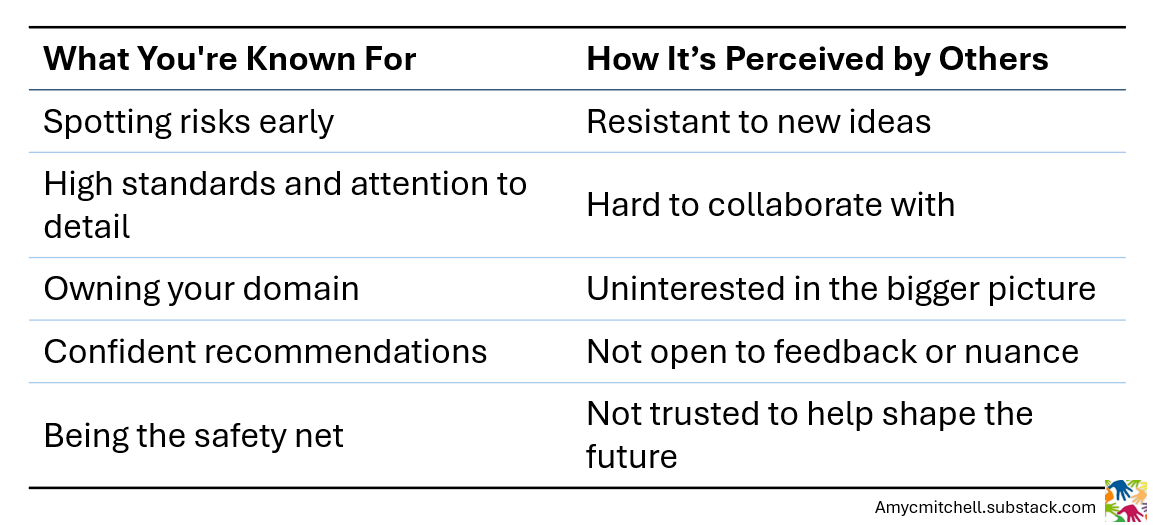You Catch Every Risk - So Why Aren't You in the Room for the Big Decisions
If you're always fixing problems but never setting direction, here's what might be happening.
Stacy is a force in the product org.
She’s sharp, detail-oriented, and always the first to catch what others miss. She keeps the team out of trouble—again and again.
You rely on Stacy to spot issues early. She’s precise and protective. Her part of the product rarely slips.
But you don’t think about her much outside of that.
So when a strategic change could affect Stacy’s area, you pause. You’re not worried about her competence—you’re worried about her reaction. Before looping her in, you go to your manager for advice.
The response is immediate:
“She lacks self-awareness.”
You laugh it off and move on.
That moment sticks with you. Stacy’s great at catching risks—so why isn’t she trusted to help set direction? Why do people work around her when it matters most?
Wait—How Can Someone So Effective Be Left Out?
If Stacy is so good at protecting the product, why isn't she invited into strategic conversations? Why do people work around her?
It’s not that her contributions don’t matter. It’s that when the team is exploring new directions, they don’t bring her in. Not early. Sometimes not at all.
So what gives?
There’s an invisible ceiling that even strong PMs like Stacy can hit. A ceiling made of perception, not capability. And it can be broken—if you understand how.
When Assertiveness Becomes an Invisible Wall
Product managers are expected to drive outcomes, make calls, and catch problems. Assertiveness, decisiveness, and attention to detail are strengths.
But those same traits—if overused—can quietly turn into rigidity, judgment, and resistance to change.
In Stacy’s case, her accuracy is trusted—but her presence in brainstorming sessions isn’t welcomed. Why? Because she shuts things down too fast. Her sharp eye is a safety net, so others wait to share with her until they’re “done.”
She’s the fixer, not the explorer.
If you’re always the one catching issues but never the one shaping direction, you might be in the same trap.
What Self-Awareness Really Looks Like (Hint: It’s Not About Being Softer)
Self-awareness doesn’t mean you stop holding the bar high.
It means understanding how your behavior lands—and adjusting without losing your standards.
The Subtle Signals You’re Being Sidelined
You won’t always get direct feedback. Sometimes self-awareness shows up in the silences.
Here are some quiet signs you’re being seen like Stacy:
You’re praised for catching issues, but rarely asked for your take on direction
Your suggestions land like final calls, not invitations to discuss
You surface real risks—but no one seems to care about them
Your fact-checking is accurate, but not driving key decisions
These patterns don’t show up in performance reviews. They show up in who’s in the room early—and who’s brought in last.
How to Get Back Into the Strategic Conversations
Even experienced PMs can drift into execution mode so deeply that they miss the bigger picture. If the signals above sound familiar, here are some tactical shifts that help:
Lead with shared goals – Frame issues in terms of what the team wants to achieve, not just what’s broken
Invite others into prevention – Make it safe for everyone to raise concerns, not just you
Share signals, not judgments – Present observations and let others help assess impact
Trade “being right” for “being influential” – Influence starts earlier when people want you in the room
Invest in systems, not heroics – Build lightweight ways for the team to catch issues together
These shifts aren't about toning yourself down—they're about making your value more usable earlier in the process.
Summary: Don’t Let Precision Cost You Your Influence
If your reputation is for catching every flaw—whether it matters or not—people will stop building with you. They’ll work around you, not with you.
The more you try to protect the product, the more you might be unintentionally walling yourself off from shaping it.
But once you shift from catching flaws to guiding outcomes, your role transforms. You’re no longer the safety net—they see you as a strategist. Someone who elevates ideas and protects execution.
You still catch risks. But now, you also shape the future.
Last week’s backstory for paid subscribers was about protecting yourself from chaos in product management. Can You Escape From The Product Management Twilight Zone?
Paid subscribers get access to 13+ templates and quick start guides.🎁
Check out Product Management Resources for free product management templates and guides.
Connect with Amy on LinkedIn, Threads, Instagram, and Bluesky for product management insights daily.







Hi. Thanks for sharing. I hope this post will also challenge Collective Conservatism or at least will make people think about it.
Great job! I am sharing with my team!